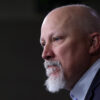The push to create “equity” and more “social justice” in public schools in California, America’s largest state, rests on this basic premise: “We reject ideas of natural gifts and talents,” declares the current draft of the California Math Framework, which also states that it rejects “the cult of genius.”
Informed by that fundamental idea, the 800-page framework calls for the elimination of accelerated classes and gifted programs for high-achieving students until at least the 11th grade.
It’s a major departure for the framework, commissioned every seven years by the Department of Education to provide guidance to the state’s 10,315 public schools serving 6 million students. Some California teachers describe it as a misguided “one size fits all” approach to reversing long-standing discrimination against girls and students of color in math instruction.
But the framework, which could be adopted next year, claims its recommendations are based on the latest, seemingly unimpeachable findings of advanced social science research. Phrases such as “researchers found,” “the research shows,” and the “research is clear” are sprinkled through the framework, which states unequivocally: “The research is clear that all students are capable of becoming powerful mathematics learners and users.”
If true, this evidence would provide a powerful rationale for adopting the framework’s proposals, which, given California’s size and prestige, is commonly seen as a model for other states.
Framework’s Research Far From Clear
A review of much of the research cited, however, reveals that what the framework describes as “clear” is often actually pretty murky, hotly disputed, or contradicted by other research, misleadingly stretched to cover situations for which it was not intended, or, in some instances, just plain wrong.
Consider how the framework supports one of its overarching principles; namely, its rejection of the “ideas of natural gifts and talents.” The text refers to a paper by a New York University psychologist, Andrei Cimpian, in 2015 to support that proposition, but the only work of Cimpian listed in the footnotes is a paper written with a Princeton University psychologist, Sarah-Jane Leslie.
That paper found that women and girls are commonly discouraged from going into fields that are deemed to require “special ability to be successful,” which can certainly include math. But it says nothing at all about whether some people are born with an aptitude for math or not, or that “all students” are capable of high-level math performance.
“This isn’t a question that my own research was designed to address,” Leslie said in an emailed response to questions about the framework’s citation of her work.
The California Math Framework is not the only document claiming that research supports woke reforms or arguments, providing a sheen of objectivity and authoritativeness to what might otherwise seem just a radical opinion. A wide range of controversial claims on subjects ranging from police shootings and school discipline policies to public health cite research that doesn’t quite prove what advocates claim.
In general, the framework follows a point of view long advocated by Jo Boaler, a professor of math education at Stanford University, the document’s most visible public advocate and reportedly its main author.
Boaler, who is white, has long argued that, as the framework puts it, “the subject and community of math has a history of exclusion and filtering rather than inclusion and welcoming.” It continues: “Girls and black and brown children notably receive messages that they are not capable of high-level mathematics compared to their white and male counterparts.”
‘Math Operates as Whiteness’
In other words, the basic premise of the framework is the same as the larger woke movement; namely, that the white male power structure systematically keeps women and nonwhites down.
“Math operates as whiteness” is the way this has been put by some specialists in math education. “One must acknowledge that mathematics is part of a societal system that is inherently racist,” reads a typical sort of blog post among math educators proposing what they call “anti-racist math.”
It is true that women—and more so African Americans and Latinos—are underrepresented in university math departments, and in science, technology, engineering, and math (STEM) fields more generally. But in math, the claim of pervasive discrimination runs more conspicuously than in other fields into a contrary, testable reality.
While bemoaning the underrepresentation of “people of color” or “black and brown children” in math, the framework almost entirely ignores the very substantial presence of both men and women who have immigrated from Asia, or are of Asian ancestry—Korean, Chinese, Indian, Pakistani, Japanese, and others.
The framework also ignores the fact that the major math departments at American colleges and universities include conspicuously large numbers of Asian immigrants and people of Asian ancestry and only a relatively small number of American-born members.
The Princeton math department, for example, is roughly four-fifths foreign-born, with many of its faculty and graduate students coming from several of the countries of East Asia and South Asia, as well as from the former Soviet Union and Eastern Europe. This alone would seem a powerful indication that math, like other scientific fields, does not “operate as whiteness.”
But Asians are only minimally mentioned in the framework’s many chapters, including those about “teaching equity and engagement in mathematics,” though the document does glancingly mention data challenging its assertion that gifted programs favor whites and males.
It reports that only 8% of white students are enrolled in California’s math classes for gifted students. While this is higher than the percentage of African Americans (4%) and Latinos (3%), it is dwarfed by the percentage of Asian Americans (32%). These numbers show that if gifted programs are phased out, the students most affected will be overwhelmingly Asian (i.e., people of color), not whites.
Born With Different Abilities
Despite this evidence, the framework’s central idea is that differences in outcome in math stem entirely from the “messages” that empower whites and males and undermine girls and people of color. It suggests these biased messages are then legitimated by the assertion that the resulting differences in performance are due to talent and ability.
Challenging this paradigm, Boaler has written that the notion that people are born with different abilities in math has been “resoundingly disproved” by “study after study.”
To support this claim, the framework relies heavily on the work of Stanford psychologist Carol Dweck, who has developed a distinction between what she calls a “fixed mindset” and a “growth mindset.”
Citing Dweck’s theory, the framework says that many math students, especially girls and children of color, somehow acquire a “fixed mindset,” the idea that they’re not good at math. If they could instead acquire a “growth mindset,” a belief that they can learn and change and get better, they will.
It’s common sense that children who believe they are poor at something are less likely to do well than students who believe they are good at that same thing, whether it’s math or music or baseball. To that point, the framework’s citation of Dweck’s theories seems fair. But Dweck herself has never gone so far as to reject the ideas of innate differences or that some students are better in some subjects than other students, or even that acquiring a “growth mindset” will enable all students to achieve high levels, in math or anything else.
“Growth mindset is about the idea that abilities are not fixed, but rather can be developed, and developed not just by hard work, but by good strategies and mentoring,” Dweck said in a Zoom interview. “That’s it. It’s not the idea that people are all the same, that they have the same abilities, or that with application they can necessarily reach the same point.”
Math and Music Talents
Sergiu Klainerman, a professor of mathematics at Princeton, went further. “It’s very clear that there is talent in math, just like there is talent in music,” he said in a Zoom interview. “You can clearly see when you teach math that there are certain kids that pick it up extremely fast, some do reasonably well but have to work hard, and there are some for whom it is difficult. The differentiation is very clear.”
Nevertheless, the framework uses its rejection of giftedness as a basis for its chief and most disputed recommendation, that accelerated classes and “tracking,” the groupings of students in separate classes according to ability, should be eliminated for all California students until the 11th grade. Until then, it proposes that students take the same math courses in the same classrooms with the same teacher.
This recommendation alone would seem to be based on a remarkably counterintuitive proposition; namely, that by eliminating fast classes and putting all students into slower ones, everybody will in the end somehow achieve more advanced results.
In support of this idea, the framework cites a 2005 study on an experiment in Rockville Centre, New York, that tracked math achievement. “When all students learned together,” the California Framework says, summing up the Rockville Centre experience, “the students achieved more.”
But, Rockville Centre, a small, well-to-do town a few miles outside New York City, is hardly comparable to California, or any large urban district. Its population of around 25,000 is 85% white and 6% black, while its mean household income is $166,000. California, by contrast, is 37% white, 6.5% black, 15.5% Asian, and nearly 40% Hispanic—and has some 40 million residents.
California’s mean household income is less than half of Rockville Centre’s. The town’s wealth enabled it to give a great deal of individualized after-school help to lower-performing students, a fact that led the authors of the study of its experience to ask: “Would the reform work in a district with fewer resources and larger numbers of struggling students?” More research, they said, would be needed to answer that question.
Moreover, what Rockville Centre did was actually the inverse of what is being proposed in California. As the Rockville Centre report puts it, the superintendent of schools there “decided that all students would study the accelerated curriculum formerly reserved to the district’s highest achievers.” The curriculum was also “algebra-based” and the measure of student achievement was based on their results on algebra-based tests.
What the framework proposes, by contrast, is to eliminate the very accelerated program that was the basis for Rockville Centre’s reported success.
One of the most controversial of the framework’s recommendations has precisely to do with algebra. Far from following the Rockville Centre model, the framework would slow down the math curriculum—specifically, by moving algebra from eighth grade, where many students take it now, to ninth grade. The rationale for this is that it will eliminate the “the rush to calculus,” which, the framework asserts, leaves many students getting only a shallow understanding of the basics that they’ll need later.
As evidence, the framework cites an article by Boaler herself—“How One City Got Math Right”—about how the San Francisco Unified School District delayed its basic Algebra 1 course from eighth to ninth grade. When it did that, Boaler reports, students getting D’s and F’s in math dropped by a third, and the number of students that had to repeat algebra fell from 40% to 8%.
“This is progress we can’t risk undoing by returning to the failed policies of tracking and early acceleration,” Boaler wrote in 2013.
Algebra as Building Block
For mathematicians, however, algebra is the essential building block for all higher math, especially advanced-placement calculus, which many elite colleges expect applicants to have taken in high school, and stopping the more gifted students from taking it in eighth grade will mean fewer students doing AP calculus in 12th grade.
“They want to hobble the strong so that everybody will be on an equal footing,” Michael Malione, a former math teacher in California who has campaigned against adopting the framework, said in a Zoom conversation. Malione and others point out that one consequence of the experiment in San Francisco was fewer students doing calculus in 12th grade.
Instead, more of them pursued a course in AP statistics— less challenging than calculus—although it could lead to careers in data science. Moreover, as Brian Conrad, a Stanford math professor, put it, the proposed data science pathway would not develop the full range of math skills needed to study data science further. Data science at the college level uses the very calculus that many students will be ill-prepared for if the framework is adopted in its current form.
“This is the shiny new thing,” Conrad said of the framework idea in a Zoom conversation, adding that at a professional level, “data science rests on solving massive optimization problems, and that is one of the crucial things that calculus does.”
“You can’t get a non-automatable data science degree if you don’t know calculus,” he continued. “And you need linear algebra, too, which builds on the skills of high school algebra. They think they’ve found this treasure trove of math that doesn’t require the later traditional stuff.”
Some of the framework’s findings directly contradict what other experts in math education have found examining California’s history of algebra instruction. In 2013, according to a paper by scholars Williamson Evers and Ze’ev Wurman, some two-thirds of students were taking algebra in the eighth grade. Some 55% of them tested “proficient or advanced” on the California Standards test, up from 40% in 2002, when most students waited until ninth grade to learn algebra.
“Between 2006 and 2012, as algebra was moved to eighth grade from ninth, the number of college-ready math students rose from 16,000 to 31,000,” they found.
“Let’s say it’s a good idea for 40% of kids to wait,” Klainerman said. “But imagine a class in which you have three or four levels. Maybe that will work out for that 40% of the class. But the 30% who are the top kids will be bored to death. You’re going to sacrifice 30% of the kids, for what?”
This article first appeared at RealClearInvestigations.com.
The Daily Signal publishes a variety of perspectives. Nothing written here is to be construed as representing the views of The Heritage Foundation.
Have an opinion about this article? To sound off, please email letters@DailySignal.com and we’ll consider publishing your edited remarks in our regular “We Hear You” feature. Remember to include the url or headline of the article plus your name and town and/or state.



























